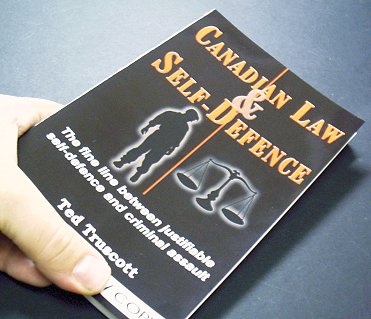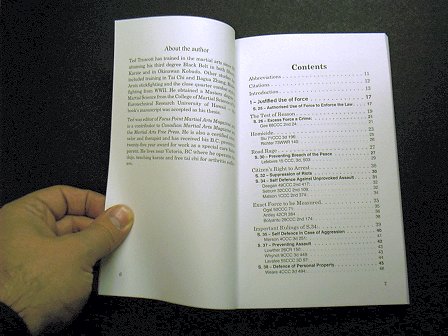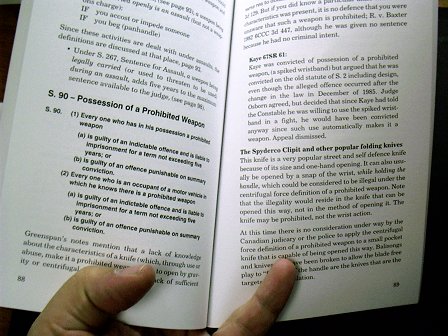its paid sponsors, whose products you need!
| Home |
| Intro |
| Current Issue |
|
Mailing List |
| Store |
| Strength |
| Subscriber Content |
| ARCHIVES
|
| Martialism |
| Pacifism |
| Q & A |
| Cunning-Hammery |
| Advertise With Us |
| Submit An Article |
| Staff |
| Discussion Forum |
| Links |
“Stay ‘unreasonable.’ If you
don’t like the solutions [available to you], come up with your
own.”
Dan Webre
The Martialist does not
constitute legal advice. It is for ENTERTAINMENT
PURPOSES ONLY.
Copyright © 2003-2004 Phil Elmore, all rights
reserved.
Canadian Law and Self-Defence
A Book Review by Tony Manifold
WARNING! This article and
Ted Truscott’s book do not constitute legal advice. Neither Ted nor
reviewer Tony Manifold is a lawyer. The commentary contained herein is
for informational purposes only and cannot be construed as advocacy of a
specific course of action.
Canadian Law and Self Defence is, to my knowledge,
the only book that deals exclusively with Canadian law (in other words, the
Criminal Code of Canada and the case law that provides the framework for
interpreting those laws) and its relevance to self-defense. I am sure there
are legal books that deal with defending against assault charges, but
Canadian Law and Self-Defence is written for martial artists by a martial
artist. This is extremely helpful, as Ted has an intimate knowledge of how we
as martial artists (and, by extension, RBSD practitioners) may differ in the
situations we face and in our responses to those situations.

Ted Truscott is a Karate and self-defense
instructor based in Victoria, BC. He has decades of martial arts
experience. They dont call him “the fighting old man” for nothing. He teaches
Shorin-ji Ryu Karate primarily but has experience in Shotokan, Modern Arnis,
and Bagua Zhang Kung Fu. He also puts on F.A.S.T. Defense seminars (with the
help of his Bulletman, Joe Ferguson) and teaches
cane fighting for
seniors. He is not a practicing lawyer and has no law degree of which I am
aware. As such, he writes this book from the perspective of a martial
artist and private citizen. With that said, this book is very well researched
and contains numerous opinions from lawyers and judges.
The book is a little dry to read. It reads very much like a textbook, full of
references and quotes with quite a bit less of Teds writing than I would have
liked. However, being only 126 pages long, it is not long enough to wear on
you. It was an easy enough read and I got through it in only a couple of
hours. The only complaint I have is that I wasnt able to get a feel for Teds
writing style. This is a shame, because Ted is a colorful guy and it would be
nice for that to come through in his text.
The publishing job is a professional one. This
is no booklet stapled together, but a proper paperback textbook. The copy sent
to me by The Martialist‘s publisher is a recently updated edition.
The changes have been made to deal with some changes to the law since the book
was originally published in 1995.
The book is broken into four parts. The first
three parts deal with the areas of the criminal code most relevant if you are
charged for defending yourself. They are Justified Use of Force, “Weapons
Offences, and Assaults. The fourth part of the book examines
how the courts deal with martial artists involved in violent scenarios. As I
said earlier, the book is written very much like a textbook. Ted details each
section of the Criminal Code, briefly explains what the sections mean, then
presents Appeals Court (a higher level court) cases in which judges have
interpreted the law in depth. This style makes it very easy to find whatever
you need. You simply look in the table of contents for the section of the
Criminal Code in which you are interested. Everything is right there for you.

Now, on to the meat of the issue. Where
does the law sit on the issue of defending yourself? I was surprised at some
of the cases in which self-defense was allowed as a defense. In many of
the cases listed, the accused was someone who brought an illegal weapon to an
illegal activity (prostitution, drugs, etc), used that illegal weapon to kill
someone who attacked him, and then successfully claimed self-defense. This
bodes well for us law-abiding citizens. One thing Canadian Law and Self-Defence
did for me was dispel the myth that the courts are out to get you and anything
but the most non-violent approach will get you jailed.
Another myth the book dispels is the idea that
you must measure the results of your response in the middle of combat.
Remember the Before and After Rule?
Canadian Law and Self-Defence gives the legal justification for such
thinking. Ted writes:
[D]ifferent situations will be judged differently and
[during] combat there is no need to stop to analyze precisely how much force
is now necessary for you to use. The courts seem to respect the so called “fog
of war” and will judge your response based on your perception of the event
when you first start to act physically.
In line with this thinking is the matter of
dealing with an armed attacker. The Appeals Court concluded that A person
defending himself against an upraised knife cannot be expected to weigh with
a nicety the exact nature of the force that he may use to preserve himself.
In other words, while you do not have carte blanche to kill anyone who
threatens you with a weapon, there is some latitude in what level of force will
be deemed justifiable.
On the issue of weapons, Ted counsels that
objects may be classed as weapons based on how they look. This means that the
super high speed 5 inch tactical knife is more likely to be judged a weapon,
whereas the 9 inch hunter may be classed as a tool. It surprised me that
we, as Canadians, have the right to arm ourselves
sort of. Edward Greenspan (a
lawyer of the Ontario Bar) was quoted saying, [Section 87, Possession of a
weapon for dangerous purposes] does not prohibit persons from arming
themselves
if the accused carries for self defence a weapon that is an
appropriate instrument with which to repel, in a lawful manner, the type of
attack reasonably apprehended and if the accused is competent [in its use].

Ted gives ample evidence that shows just how
important it is to been seen to make every effort not to fight. Under Canadian
law, if you consent to a fight there is no assault if you are then struck.
This means you must be very careful with your words and actions. If you imply
consent, you may lose your right to claim self-defense. As an interesting side
note, Ted includes a small section on duels.
The final part of the book deals with how
courts look on martial artists or anyone else deemed to be trained.” The cold
reality is that some judges assume that martial artists have the ability to
defeat their attackers without hurting them. This supports the notion that you
must be able to defend every action you take. Ted describes a civil suit against
a night club in which a patron was subjected to a lateral neck restraint by
a bouncer whilst being ejected from the club. The bouncer was Al Carty, an
accomplished and very experienced martial artist. In this case, Mr. Cartys
long martial arts background worked against him. It should be noted that Mr.
Carty did a very good job in using his background as a defense. He said, in
effect, that because of his background he knew what he was doing and could apply it
safely. In a criminal case he may well have been absolved of any wrongdoing,
but in a civil case the outcome is determined by a balance of probability and
is much easier to lose.
Overall, Canadian Law and Self-Defence is very informative and would
serve as a great reference for further training for any Canadian. I believe that if one owned
this book and had to face criminal charges, it would be a good text to give
to ones lawyer to keep him on the right track. The book is put together
well,
very organized, and contains information that is easy to find and digest. I would
recommend it to Canadian martial artists and self-defense practitioners who
wish to see where they stand in the eyes of the law.
I am definitely better off
for reading it.
